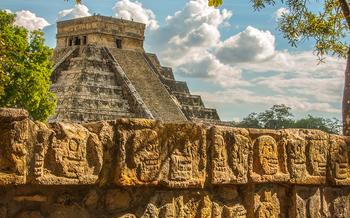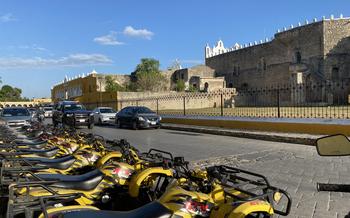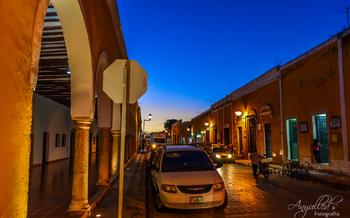
Grutas de Loltun
- Ancient Mayan Cenote
- Getting to the Grutas de Loltun
- The Entrance and Ticket Prices
- Exploring the Caves
- The Hall of Columns
- The Throne Room
- The Cave of the Hands
- The Altar of the Skulls
- The Cenote of the Virgin
- Photography and Videography
- Facilities and Amenities
- Nearby Attractions
- Insider Tip
Ancient Mayan Cenote
The Grutas de Loltun are a series of underground caves located in the Yucatán Peninsula of Mexico, near the town of Oxkutzcab. The caves are home to a variety of natural formations, including stalactites, stalagmites, and columns, as well as a cenote, or natural sinkhole.
The cenote, known as X'tacumbil-Xuna'an, is a sacred site for the ancient Maya and is believed to have been used for religious ceremonies and rituals. The cenote is located at the end of a long tunnel within the caves and is surrounded by impressive rock formations. The water in the cenote is crystal clear and is a popular spot for swimming and snorkeling.
The Grutas de Loltun were first explored by archaeologists in the 19th century, and excavations have revealed a number of artifacts from the Maya civilization, including pottery, tools, and jewelry. The caves are also home to a number of bats, which can be seen flying overhead as you explore the caves.
Getting to the Grutas de Loltun
The Grutas de Loltun are located in the state of Yucatán, Mexico, approximately 60 kilometers (37 miles) southeast of the city of Mérida. The caves are situated near the village of Loltún, which is easily accessible by car or guided tour.
If you are driving, take the highway 180 towards Valladolid and turn right at the sign for Loltún. The caves are about 5 kilometers (3 miles) from the village. There is a parking lot at the entrance of the caves where you can leave your vehicle.
There are several guided tours available that can take you to the Grutas de Loltun. These tours typically depart from Mérida or Cancun and include transportation, a guided tour of the caves, and a visit to the nearby cenotes. Guided tours are a great option if you want to learn more about the history and culture of the caves and the surrounding area.
The Entrance and Ticket Prices
The Grutas de Loltun are open to the public daily from 8:00 AM to 5:00 PM, providing ample opportunities for exploration. For those planning a visit, ticket prices are set at a reasonable rate to ensure accessibility. Adults can purchase tickets for approximately $15 USD, while children and students with valid identification can enjoy a discounted rate of around $10 USD. Additionally, special offers and discounts may be available during certain periods or for specific groups, making it worth checking for any ongoing promotions before your visit.
Exploring the Caves
Guided tours are available for visitors to delve deeper into the mysteries of the Grutas de Loltun. Led by knowledgeable local guides, these tours provide fascinating insights into the history, geology, and cultural significance of the caves. The guides will lead you through the various chambers, pointing out remarkable rock formations, ancient Mayan altars, and remnants of past ceremonies.
A typical tour lasts for about an hour, allowing ample time to explore the most awe-inspiring sections of the caves. As you journey through the subterranean labyrinth, you will be amazed by the intricate stalactites and stalagmites that adorn the walls and ceilings. These natural sculptures, formed over thousands of years by the slow drip of water, create an ethereal atmosphere that transports you to another world.
The tour also includes a visit to the Cenote X'tacumbil-Xuna'an, a breathtaking natural pool of crystal-clear water located deep within the caves. This cenote offers a unique opportunity for swimming and snorkeling, allowing you to immerse yourself in the pristine waters and admire the vibrant underwater life.
The Hall of Columns
Venturing deeper into the caves, visitors will encounter the awe-inspiring Hall of Columns, a natural chamber adorned with majestic rock formations that resemble towering columns. These geological wonders, carved by water over millennia, create an otherworldly atmosphere within the subterranean realm.
Impressive Rock Formations: - Admire the grand columns that rise from the cave floor to the high ceiling, forming a natural cathedral-like setting. - Marvel at the intricate patterns and textures etched into the limestone walls, a testament to the power of nature's artistry.
Mayan Altars and Offerings: - Discover ancient Mayan altars and offerings carefully placed among the columns, suggesting the cave's significance as a sacred site. - Imagine the rituals and ceremonies that once took place here, invoking the gods and seeking their favor.
Historical and Cultural Significance: - Learn about the Hall of Columns' historical and cultural importance as a gathering place for the ancient Maya. - Gain insights into their beliefs, traditions, and reverence for the natural world, which found expression in their use of this sacred space.
The Throne Room
In the heart of the Grutas de Loltun lies the Throne Room, a majestic chamber that once served as a sacred ceremonial space for the ancient Mayans. Dominating the room is a striking throne-like structure, carved from the natural rock formations with intricate detailing. Its imposing presence exudes an aura of power and authority.
This throne was not merely a seat of political leadership but held profound religious significance. It was here that Mayan rulers, adorned in elaborate regalia, conducted sacred rituals and ceremonies, mediating between the earthly realm and the divine. The throne room served as a microcosm of the Mayan cosmos, where the earthly and spiritual realms converged.
The walls of the Throne Room are adorned with bas-relief carvings depicting various Mayan deities and symbols. These carvings provide valuable insights into the Mayan belief system and their reverence for the natural world. The room's acoustics are also remarkable, amplifying the voices of the Mayan rulers as they performed their sacred incantations.
Standing in the Throne Room, one can almost feel the weight of history and the palpable presence of the ancient Mayan rulers. It is a place where the past and present intertwine, creating a powerful connection to the rich cultural heritage of this ancient civilization.
The Cave of the Hands
At the heart of the Grutas de Loltun, you will discover the enchanting Cave of the Hands, a testament to the rich beliefs and traditions of the ancient Mayans. As you enter, your eyes will be drawn to the walls adorned with hundreds of ancient handprints, each one a unique imprint of a long-lost soul. These handprints, left by the Mayans, are believed to represent a connection to the underworld, a realm where the spirits of their ancestors resided.
The Mayans believed that by pressing their hands against the cave walls, they could establish a connection with the spirits of their deceased loved ones. This practice was not only a way to honor their ancestors but also a means to seek guidance and protection from them. The handprints, therefore, serve as a poignant reminder of the deep spiritual connection the Mayans shared with their ancestors and the afterlife.
Beyond the spiritual significance, the Cave of the Hands offers a glimpse into the artistic expressions of the Mayans. The handprints vary in size and shape, some small and delicate, others large and bold, each one a testament to the individuality of its creator. Some handprints are accompanied by intricate designs, revealing the artistic talents of the ancient Maya people.
Exploring the Cave of the Hands is a truly humbling experience, as you are reminded of the rich cultural heritage of the Mayans and their deep connection to the spirit world. It is a place where the past and present intertwine, creating a sense of awe and wonder that will stay with you long after your visit.
The Altar of the Skulls
Within the depths of Grutas de Loltun lies a chilling testament to ancient Mayan rituals – the Altar of the Skulls. This unique altar features several carved skulls, each bearing a distinct expression and intricate details. These skulls are believed to have served as offerings to the Mayan gods, particularly those associated with the underworld and the cycle of life and death.
The Mayans believed that death was not an end but rather a transition to another realm. They often conducted elaborate rituals and ceremonies to honor their deceased ancestors and to appease the gods of the underworld. The Altar of the Skulls is believed to have been a sacred space where these rituals took place.
The skulls on the altar are thought to represent individuals who were sacrificed to the gods. Human sacrifice was a common practice among the Mayans, and it was believed that sacrificing a life would bring favor and protection from the divine. The skulls serve as a reminder of the complex and often macabre religious beliefs of the ancient Mayan civilization.
Discovering the Altar of the Skulls within the Grutas de Loltun provides a glimpse into the fascinating and sometimes unsettling world of Mayan rituals and sacrificial practices. It is a powerful reminder of the rich cultural heritage and the enduring fascination with death and the afterlife that characterized this ancient civilization.
The Cenote of the Virgin
Tucked away within the depths of the Grutas de Loltun lies a secluded and mystical cenote known as the Cenote of the Virgin. This small, yet enchanting body of water holds a special place in the hearts of locals and visitors alike, owing to its captivating legend and religious significance.
According to local lore, the Cenote of the Virgin is associated with the miraculous appearance of the Virgin Mary. It is said that during a time of great hardship, the Virgin Mary appeared to a group of faithful villagers, offering solace and guidance. In her honor, the villagers constructed a small altar beside the cenote, where they would gather to pray and seek her protection.
The Cenote of the Virgin has since become a place of pilgrimage for devotees from near and far. Believers come to pay homage to the Virgin Mary, seeking her blessings and intercessions. The cenote's serene atmosphere and crystal-clear waters create a sacred and contemplative space, inviting visitors to reflect and connect with their spiritual side.
Photography and Videography
Inside the Grutas de Loltun, visitors are permitted to capture the stunning beauty of these natural wonders through photography and videography. The dimly lit caves, with their glistening stalactites and stalagmites, offer a unique and atmospheric backdrop for your shots. To ensure you capture the best images, consider bringing a sturdy tripod to stabilize your camera and avoid blurry photos. A wide-angle lens can also be useful for capturing the expansive views within the caves.
When taking photos or videos, be mindful of respecting the natural beauty and cultural significance of the site. Avoid using flash photography, as this can damage the delicate cave formations and disturb the wildlife that inhabits the caves. Instead, use natural light or a flashlight to illuminate your subjects. Remember that these caves are a sacred place for the Maya, so be respectful and avoid taking photos or videos that could be considered offensive or disrespectful.
Facilities and Amenities
To ensure a comfortable and enjoyable visit to the Grutas de Loltun, several facilities and amenities are available for tourists. Modern and well-maintained restrooms are located near the entrance, allowing visitors to freshen up after their exploration. Changing facilities are also available for those who wish to change into their swimwear before taking a dip in the refreshing cenotes.
For those seeking to take home a piece of their adventure, souvenir shops and local vendors line the entrance to the caves. Here, visitors can find a variety of handcrafted items, including pottery, jewelry, and traditional Mayan textiles, all made by local artisans. These souvenirs serve as a cherished reminder of the beauty and culture encountered within the Grutas de Loltun.
After a day of exploration, visitors can indulge in delicious local cuisine and beverages at the on-site restaurant and snack bar. A range of traditional Mexican dishes, as well as refreshing drinks and snacks, are available to satisfy every palate. Enjoying a meal while surrounded by the natural beauty of the Yucatan jungle makes for a truly memorable experience.
Nearby Attractions
The Grutas de Loltun are just one of the many natural and cultural wonders that Yucatán has to offer. In the vicinity of the caves, there are several other caves and cenotes that are worth exploring, such as the Cenote Suytun, the Cenote Samulá, and the Grutas de Balankanché. These caves offer unique formations, crystal-clear waters, and a chance to see bats, spiders, and other cave-dwelling creatures.
History buffs and culture enthusiasts can also visit the nearby Mayan ruins of Chichén Itzá, Ek Balam, and Uxmal. These ancient cities offer a glimpse into the rich history and culture of the Mayan civilization. With towering pyramids, intricate carvings, and well-preserved temples, these archaeological sites are a must-visit for anyone interested in the ancient world.
For a more immersive experience, consider visiting the colonial towns of Valladolid and Izamal. These charming towns offer a glimpse into Mexico's colonial past, with colorful buildings, cobblestone streets, and historic churches. Take a leisurely stroll, sample the local cuisine, and learn about the region's unique traditions and customs.
The Yucatán Peninsula is a treasure trove of natural and cultural attractions, and the Grutas de Loltun are just a small part of it. Whether you're interested in history, culture, or simply exploring the great outdoors, you'll find plenty to see and do in this vibrant region.
Insider Tip
To fully immerse yourself in the magic of the Grutas de Loltun, consider visiting during the off-season, which runs from May to October. During this time, you'll encounter fewer crowds, allowing you to have a more intimate and serene experience. The cooler temperatures also make it more comfortable to explore the caves.
Take advantage of the knowledgeable local guides who can provide insights into the history, culture, and significance of the Grutas de Loltun. Their stories and explanations will bring the caves to life and help you appreciate the rich Mayan heritage that surrounds them. Embrace the opportunity to learn from these passionate individuals who are dedicated to preserving and sharing their culture.









